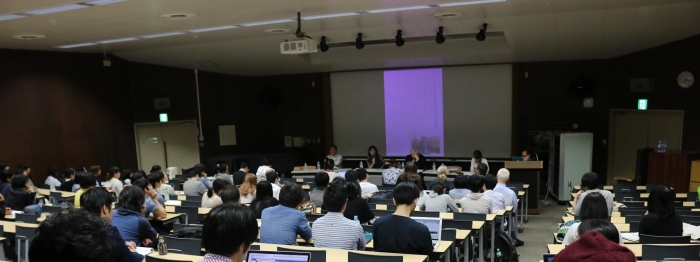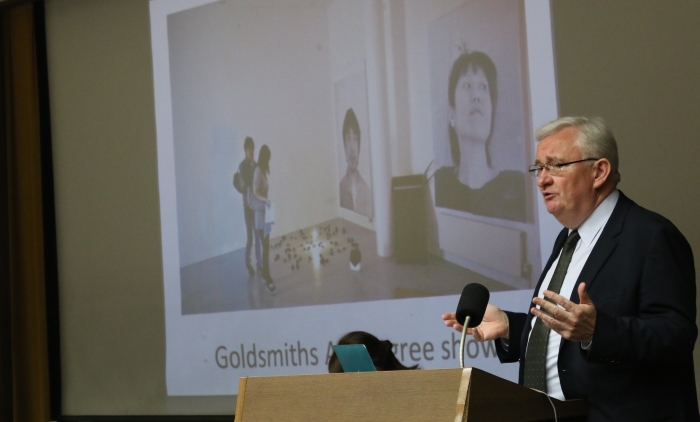公開シンポジウム「グローバル時代の芸術大学の未来」Public Symposium “The Future of Art Universities in the Age of Globalization”
June 03, 2015
グローバル化の時代、芸術大学はどのように変化するのでしょうか?
デミアン・ハーストやスティーヴ・マックイーンをはじめイギリスを代表するアーティストを輩出し、メディア文化研究や社会学で国際的に高い評価を受けているロンドン大学ゴールドスミスカレッジのパトリック・ロックリー学長を特別ゲストに迎え、5月26日、東京藝術大学において、芸術大学の未来について議論しました。
パトリック・ロックリー学長の講演
シンポジウムの前半では、パトリック・ロックリー学長の講演が行われました。
自身のキャリアをBBC(British Broadcasting Corporation;英国放送協会)でスタートさせたパトリック学長は「BBCでは伝統・創造・管理などの異なる要素やその実践・手法が同時に求められており、それは大学も同じである」とし、「大学においては、様々な目的・様々な尊敬の対象を持つ者が束になっており、その異なるものの間にいかにして糸を張るかが重要だ」と述べました。
また、ゴールドスミスカレッジの学生は、同校に入学した時から芸術家として扱われる、という話題を挙げ、「ゴールドスミスは自由で創造的だが、学生は常に、自分の作品についての問いに答えられるだけの準備をしておかなければならない」と話し、スティーヴ・マックイーンが同校について「何をしてもいいという自由さに、精神的にまいった」と述べたエピソードが紹介されました。
パトリック学長は「自由でありながらも誰もがお互いの批評家となり、問いと対話によって作品を研ぎ澄ませ、前に進めていくことが大事である」とし、「リスクをとらずに、勇気をもたずに成功した人はいない」と語り、講演を締め括りました。
公開討論「グローバル時代の芸術大学の未来」

シンポジウムの後半では、「グローバル時代の芸術大学の未来」というテーマについて、パトリック学長と、本学・音楽環境創造科の熊倉純子教授、市村作知雄准教授が意見を交わしました。
「未来の芸術大学を問う以前に、未来に芸術はあるのか? あるとすればどういう形なのか?」という導入から始まった討論では、昨今の多くの芸術作品に見られる「Participation;参加」や「Collaboration;協同」というコンセプトを引き寄せ、それが芸術であるかどうかを問うこと自体が無駄になってくるのではないか、あるいは、芸術大学が引き取ることができない芸術の領域が現れるのではないか、といった刺激的な言葉が提示されました。
また、昨今の芸術をめぐる状況を「作品も作者も溶解しつつある」と捉え、それは、境界線が曖昧であり、また、伝統が残りながらも新しいものが同時に走り始めるという特徴をもつアジア的な価値観に結集しているのでは、という考えが挙げられ、西洋近代美学との対比がなされました。
そうした中で、芸術大学は教育機関として「社会にどういった貢献ができるのか?」を改めて問うべきであり、また、いまいちど「世界の理解のしかた」を教えることが大学の役目であるとし、平成28年度に「国際芸術創造研究科」の創設を目指す東京藝術大学が、そこでの活動にどういった思想・アイデア・社会性・同時代性を持ち込むかということによって、未来の芸術大学のひとつの形を示すことになるだろうことが語られました。
最後はパトリック学長から「メディアよりもメッセージが大事だ。どうやって神を笑わせるか考えよう」という言葉が述べられ、会場に集まった多くの学生から、拍手が送られました。

How are art universities going to change in the age of globalization?
On May 26, 2015, Tokyo University of the Arts held a symposium to discuss the future of art universities, having Mr. Patrick Loughrey as a special guest from the United Kingdom. Mr. Loughrey is Warden of Goldsmiths, University of London, which is highly regarded for its research on media culture and sociology, and whose distinguished alumni include Damien Hirst, Steve McQueen, and many other leading British artists.
(The original language of this article is Japanese. Please note that this is a tentative translation prepared for publicity purpose, and that the phrases used in this article may not correspond with the expressions actually used by the speaker.)
Mr. Patrick Loughrey’s Presentation
The first half of the symposium featured a presentation by Mr. Patrick Loughrey.
Mr. Loughrey, who started his career at BBC (British Broadcasting Corporation), said that there were many factors to consider at BBC, such as tradition, creativity, management, while there was a demand for different means and practices at the same time. He pointed out that the same could be said about the role of universities, saying that universities are where people with different purposes and different objects of respect come together and it is important how we connect the dots of such different factors.
Mr. Loughrey also talked about how students at Goldsmiths are treated as artists since the beginning of their college life. He described the college as free-spirited and creative, where students have to be prepared to answer questions about their works all the time. To illustrate this point, he shared with us a story that film director Steve McQueen once said that he felt overwhelmed because he had too much freedom.
Mr. Loughrey concluded his talk by saying that every student should play the role of critic for one another and polish their works through questioning and dialogues in order to advance. He added that no one ever succeeded without the courage to take risks.
Panel Discussion on the Future of Art Universities in the Age of Globalization

The second half of the symposium featured a panel discussion on the theme “the Future of Art Universities in the Age of Globalization,” joined by Prof. Junko Kumakura and Associate Prof. Sachio Ichimura of our university’s Department of Music Creativity and the Environment, along with Mr. Loughrey.
Before exploring the future of art universities, will there be arts in the future in the first place? If so, in what forms will they exist? The discussion opened with this introductory question. Noting that recent art works often draw on concepts like “participation” and “collaboration”, the panelists gave thought-provoking comments by saying that there would be no point in discussing if such works could be called arts any more, and that there would emerge new fields of arts that could not be dealt with at art universities.
Furthermore, referring to the current state surrounding arts, the panelists pointed out that the notion of art and artist was becoming ambiguous. While making a comparison with the Western modern aesthetics, they discussed that perhaps this was due to the spread of Asian values, where boundaries are vague and new innovations coexist with traditions.
With this in mind, they said, art universities should ask themselves how they can contribute to the society as an educational institution and re-examine their role as a university to teach students how to understand the world. The panelists shared their view that Tokyo University of the Arts, which is planning to launch the Graduate School of Global Arts, Course of Arts Studies and Curatorial Practices in 2016, could serve as a model of future art university, depending on how it will incorporate factors such as visions, ideas, social aspects, and contemporaneity, into its education.
The symposium closed with Mr. Loughrey’s words of encouragement. He concluded that the message is more important than the medium, and invited students to think about how they can make God smile. The students in the audience responded with a round of applause.



